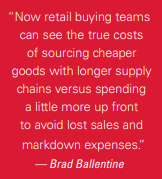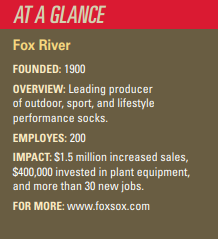Fox River produces high-performance socks at a plant in Osage. The company has increased sales, invested in new equipment, and added jobs since implementing a new sales approach based on a Total Cost of Ownership (TCO) model.

The Osage manufacturer has seen revenues increase by $1.5 million since updating their sales approach with a TCO model developed in partnership with CIRAS.
Fox River has been a leading producer of outdoor, sport, and lifestyle performance socks since 1900. Though sales of their products were impacted at the start of the COVID pandemic, company leaders were convinced that the right tool could help them reverse the trend and support efforts to grow revenue.
“They needed something to illustrate to their clients not only the direct cost per unit but also the other expenses such as freight, duty, purchasing, and indirect costs,” said Marc Schneider, CIRAS project manager. “That’s where a customized TCO model comes in. It gathers and compares all relevant data associated with getting or owning a product from suppliers in different global locations. And that helps customers make a more informed decision about the products they buy.”

CIRAS held a series of online meetings with Fox River to gather information in five categories ranging from actual product price to transportation fees to inventory and warehousing costs. Factors unique to overseas goods such as duty taxes and import fees, rate of labor cost increases, and changes in currency rates, as well as supply chain risks, were also considered.
“The TCO model adds up all the costs associated with each of these factors and then does a side-by-side comparison with other suppliers,” Schneider said. “Typically, we find that the purchase price per unit might be lower for items sourced from low-cost countries, but the TCO per unit for a domestically sourced product is similar to—and sometimes even lower than—goods from an overseas supplier.”
After adapting the TCO model to the unique needs of Fox River, CIRAS worked with the company as they successfully piloted a presentation using the model. Fox River continues to use the TCO approach.

“The TCO model that was built by the CIRAS team allows for clear buying decisions,” said Fox River CEO Brad Ballentine. “Now retail buying teams can see the true costs of sourcing cheaper goods with longer supply chains versus spending a little more up front to avoid lost sales and markdown expenses.”
“We look forward to further implementation of the TCO model with our customers and the expansion of the measurements to include environmental impact,” Ballentine continued. “As we highlight the savings associated with shorter lead times, we are seeing a correlation to sustainability efforts. Shorter supply chains help reduce waste associated with overproduction along with reduced transportation emissions associated with long supply chains.”
Additional sales revenue has enabled Fox River to invest more than $400,000 in plant equipment and information systems. The company has also added more than 30 new jobs.
For more information, contact Marc Schneider at maschn@iastate.edu or 563-221-1596.